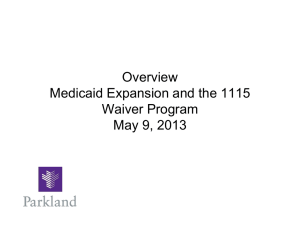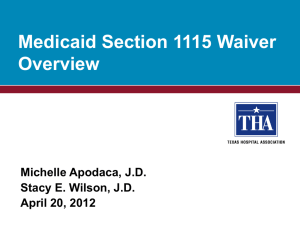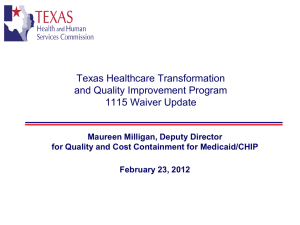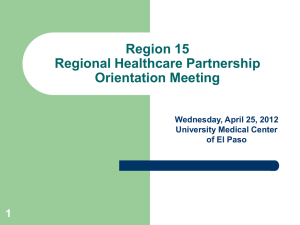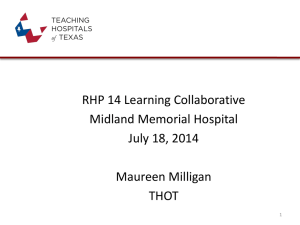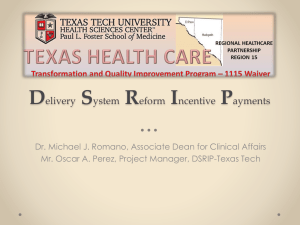1115 Waiver - Alliance for Healthcare Excellence
advertisement
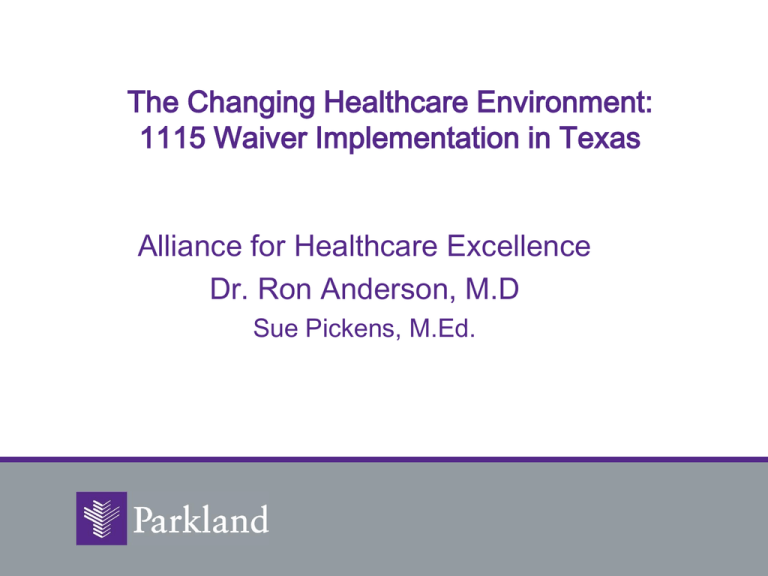
The Changing Healthcare Environment: 1115 Waiver Implementation in Texas Alliance for Healthcare Excellence Dr. Ron Anderson, M.D Sue Pickens, M.Ed. 2 1115 Waiver • Waiver Goals • Expand risk-based managed care statewide. • Support the development and maintenance of a coordinated care delivery system. • Improve outcomes while containing cost growth. • Protect and leverage financing to improve and prepare the health care infrastructure to increase access to services. • Transition to quality based payment systems in managed care and in hospital payments. • Provide a mechanism for investments in delivery system reform including improved coordination in the current indigent care system in advance of health care reform. 3 1115 Waiver • Waiver’s impact is state and local, rather than federal • Works whether the healthcare reform law remains intact or not • Milestones • Expansion of primary care • Behavioral health goals • Specialty care access goals • DSRIP and UC more than doubles the former UPL annual payment 4 1115 Waiver • Under the waiver, additional new funds are distributed to hospitals through two pools: • Uncompensated Care (UC) Pool : Costs of care provided to individuals who have no third party coverage for the services provided by hospitals or other providers (beginning in first year). • Delivery System Reform Incentive Payments (DSRIP): Support coordinated care and quality improvements through Regional Healthcare Partnerships (RHPs) to transform care delivery systems (beginning in later waiver years). Proposed RHP Map 5 6 1115 Waiver – CMS Expectations CMS Expectations • Planning process that demonstrates regional collaboration. • Projects selected address community needs identified through a Community Needs Assessment (DFWCH) • Projects selected are the most transformative for the region. • RHP Plan includes projects that tie into four categories established y HHSC to demonstrate outcomes • • • • Infrastructure Innovation Quality Reporting 7 Uncompensated Care Pool • Anchor Hospital (IGT Entity) – Provides funds to HHSC for match • Hospitals apply directly using a state designed tool to receive UC payments to include: • • • • Physician costs related to direct patient care services Mid-level professional costs related to direct patient care services Pharmacy costs related to he “Texas Vendor Drug” program Excess “Medicaid DSH” costs not reimbursed via the Medicaid DHS program • Specific tool for submitting reimbursement provided by HHSC through TexNet (not yet available) DSRIP Pool – Funding Flow • Public Hospital • In areas with no public hospital: • Hospital District • Hospital Authority’ • County • State University with HSC or medical school Reporting Anchor RHP Administrative Functions HHSC Approves performance IGT Entity Reviews performance Examples: Public Hospital Public Hospital Public Hospital LMHA Payments Funding Source HHSC Requests IGT from IGT Entities CMS Approves Federal match and sends to HHSC Performing Provider Reports Performance Examples: Public Hospital Private Hospital Private Hospital LMHA Clinic IGT Entity Provides IGT to the State HHSC Requests federal match from CMS HHSC Provides payments to performing provider Performing Subcontractor Reports performance to performing provider Performing Provider Receives payments Performing Subcontractor Receives payments from performing provider. 8 Texas Healthcare Transformation and Quality Improvement Program Section 1115 Waiver Program Region 9 RHP Organization Ensuring Regional Collaboration Anchors development of the Dallas RHP and the RHP Plan: Develops the Dallas RHP Plan Designates Dallas Regional Healthcare Partners (Dallas RHPs) Performs a community needs assessment that serves as basis for the RHP plan Approves Dallas Intergovernmental Transfer (IGT) contributions Approves selected Dallas regional DSRIP projects from the State approved menu of projects Allocation of funds to UC and DSRIP projects Provides an opportunity for public input and review of the RHP Plan Provides ongoing Dallas RHP plan administration and reporting. Develop Dallas Regional Health Partnerships Plan: • Designating Dallas Regional Healthcare Partners • Community Needs assessment • Identify and approve IGT contributions • Approve selected Dallas regional DSRIP projects • Approve allocation of funds to UC and DSRIP projects • Provide opportunity for public Input and review of the RHP Plan • Ongoing Dallas RHP Plan administration and reporting Centers for Medicare and Medicaid Services (CMS) Texas Health and Human Services Commission (HHSC) Dallas County Hospital District Board of Managers (DCHD – Dallas Anchor) Regional Healthcare Partnership (RHP) Partner with DCHD to develop the Dallas RHP and RHP Plan: •Serve as a forum for the work group and task forces to develop required elements for the RHP/RHP plan. •Assure range of Dallas stakeholders are involved •Assist in project management and ensure project transparency •Assist in coordinating Dallas’ input to DHHS on statewide elements of waiver program Dallas Medical Resource Oversight Work Group Co-Chairs Tom Royer MD and Joel Allison (Dr. Royer was replaced by Ted Shaw) 1115 Waiver Steering Committee Tom Royer MD (Dr. Royer replaced by Ted Shaw) Committee replaced with the Plan Writing Committee Delivery System Redesign Incentive Pool Task Force Co-Chairs Ron Anderson MD and David Ballard MD A work group designated by DMR and DCHD will serve as the project steering committee responsible for: • Developing recommendations to the DCHD Board of Managers on the Dallas Regional Healthcare Partners Plan Uncompensated Care Pool Task Force Co-Chairs John Dragovits and Fred Salvelsbergh (John Dragovits replaced by Jody Springer) Texas Healthcare Transformation and Quality Improvement Program Section 1115 Waiver Program Region 10 RHP Organization Ensuring Regional Collaboration Region 10 DRAFT Regional Healthcare Partnership Planning Approach Regional Healthcare Partnership Planning Organizing & Learning Planning Assessment •DSRIP Development & Coordination (Support & Guidance for RHP participants) •RHP Proposal Development •Participant and Electeds Buy-In & Engagement •Interviews, Focus Groups & Survey •Provider Assessments (Readiness, Strengths & Gaps) •IGT Assessment (Finances/available funds) •Community & Regional Needs Assessments •Orientation •Education & Communication •Engagement •Committee Development •Consensus on Principles for Success •Establish “Collaborative” Governance Phase 1: Local Partner Development Today (April 20 2012) April • Stakeholder engagement • RHP Committee formation •Execution & Partner Development at Local Level •Elevate “the game” of individual players & health networks in each county •Achieve process & preliminary milestones 6 Month May June • Centralized community Needs Assessment workshops • Provide Community Needs Assessment templates, baseline data, guidance and technical assistance • Provide DSRIP parameters, metrics and guidance per THHSC & RHP (if allowed) • Develop individual County Community Needs Assessments • Conduct individual County Visioning Sessions • DSRIP coordination, development & evaluation process Phase 2: Regional Execution Year 1 Year 2 July • Develop RHP-wide Community Needs Assessment • Begin RHP Plan Development • Community forums for plan review • Finalize DSRIP plans •Synergy of RHP Partners •Implementation of Regional Strategies •Learn to play well together as a region, elevating performance as a team to provide better care at lower cost for RHP •Achieve broader outcomes & long-term milestones Year 3 August • Draft plans to THHSC 8/1 • Draft plans to CMS 8/31 Year 4 September • Review/ update plans based on feedback Year 5+ October • Final plans to CMS Regional Healthcare Partnership Committees Elected Leaders County Judges other elected officials responsible for IGT entities Steering CEOs of Local & Regional participant Hospitals, MHMR and School of Medicine Planning Planning officers of participant Hospitals, MHMR, Public Health and School of Medicine Finance (IGT and UC) Finance officers of participant Hospitals, MHMR and School of Medicine Quality/Clinical Quality/Medical officers of participant Hospitals, MHMR, Public Health, School of Medicine, Medical Associations Regional Healthcare Partnership Collaborative “Governance” Guiding Principles Transparency Ensure that decision making process takes place in the public eye and that processes are clear to participants Patient-Centered RHP and criteria should focus on improving patient care & experience through more efficient, patient-centered and coordinated system Collaborative RHP informed by collaborative process that reflects the needs of the community(s) in inputs of stakeholders Value-Driven RHP should focus on increasing value to patients, community, payers and other stakeholders. Better Care, Less Cost Accountability Stakeholders are held to common performance standards, deliverables and timelines Pool Funding Distribution Transformation is the Goal Pool Funding Distribution in Billions DY* 1 DY 2 DY 3 DY 4 DY 5 Pool Type UC DSRIP (2011-2012) (2012- 2013) (2013- 2014) (2014-2015) (2015-2016) $3.7 $0.5 $3.9 $2.3 $3.534 $2.666 $3.348 $2.852 $3.1 $3.1 Totals $17.582 $11.418 Total/DY $4.2 $6.2 $6.2 $6.2 $6.2 $29 % UC 88% 63% 57% 54% 50% 60% % DSRIP 12% 37% 43% 46% 50% 40% Page 11 12 RHP Category 1 and 2 Minimum Number of Projects • Four Tiers based on share of the statewide population under 200 percent of the federal poverty level (FPL) Share of population under 200% FPL Min number of Cat 1 and 2 projects Min number of Cat. 2 projects Tier 1 >15% 20 10 Tier 2 (Regions 9 and 10) 7-15% 12 6 Tier 3 3-7% 8 4 <3%, no public hospital, or public hospitals serve <15% UC 4 1 Tier 4 (Region 18) RHPs and DSRIP • RHP Plans include: • • • • Regional health assessments Participating local public entities Public engagement Identification of hospitals receiving incentives and of yearly performance measures • Incentive projects by DSRIP categories • RHPs and RHP plans do not: • Require four-year local funding commitments • Determine health policy, Medicaid program policy, regional reimbursement, or managed care requirements 14 Dallas Fort Worth Hospital Council Community Needs Assessment Report.: RHP 9 – Findings (DRAFT) The following regional priorities were identified as primary community health needs and are recommended for consideration as context for identification of strategies and recommended actions of the regional plan: Capacity - Primary and Specialty Care • The demand for primary and specialty care services exceeds that of available medical physicians in these areas, thus limiting healthcare access for many low level management or specialized treatment for prevalent health conditions. Behavioral Health - Adult, Pediatric and Jail Populations • Behavioral health, either as a primary or secondary condition, accounts for substantial volume and costs for existing healthcare providers, and is often utilized at capacity, despite a substantial unmet need in the population. Chronic Disease - Adult and Pediatric • Many individuals in North Texas suffer from chronic diseases that present earlier in life, are becoming more prevalent, and exhibit more severe complications. Patient Safety and Hospital Acquired Conditions • Continued coordinated effort is needed to improve regional patient safety and quality. Emergency Department Usage and Readmissions • Emergency departments are treating high volumes of patients with preventable conditions, or conditions that are suitable to be addressed in a primary care setting. Additionally, readmissions are higher than desired, particularly for those with severe chronic disease or behavioral health. 15 Stakeholder Engagement Stakeholder Engagement • RHP Participant Engagement • Information for Performing Providers including hospitals, Community Mental Health Centers, Academic Health Science Centers and Local Health Departments. • Public Engagement • Processes used to solicit public input into RHP Plan and public review prior to plan submission, including county medical societies. • Must include a description of public meetings and posting of RHP Plans for input. • Plan for ongoing engagement with public stakeholders. 16 RHP Plans and CMS Expectations – Regional Transformation • Transparent planning process that demonstrates regional collaboration and public input. • Projects selected address community needs and regional goals. • Projects selected are the most transformative for the region • RHP Plan includes projects that tie to the four DSRIP categories together to demonstrate outcomes • RHP Plan includes broad UC and DSRIP participation. 17 Funds Flow Mechanics DSRIP Pool The allocation of the DSRIP Pool is quite complex with respect to both the allocation to regions and the allocations within each region Allocate from State Pool to Regions for years 205 Percent of population < 200% FPL Percent of Medicaid acute care payments Percent of UPL program payments Pass 1 Allocation within RHP to Performing Provider Hospitals Targeted to receive 75% of funds Must have participated in DSH or UPL programs Allocated on basis of: Percent of Medicaid payments, Percent of UPL, Percent of UC Non Hospitals Community mental Health Centers – 10% Academic Physicians Practices - 10% Local Health Departments- 5% Conditions Meet minimum number of projects; each project capped generally at $20m for 4 years Require participation for major safety net hospitals (at least 4) Broad hospital participation – at least 30% of the pool allocated to private hospitals Pass 2 Allocation of Excess Funds Conditions To be eligible to have a Pass 2, the conditions of Pass 1 must be met Hospitals Non DSH/UPL providers – 15% Additional projects for pass 1 participants Non Hospitals Non academic physician practices – 10% Additional projects of Pass 1 participants 18 Eligibility for “Pass 2” Major Safety Net Hospital Participation • A minimum number of major safety net hospitals must participate in DSRIP as Performing Providers based on Tier level. Tier 1 At least 5 Tier 2 At least 4 Teir 3 At least 2 Tier 4 At least 1 At least 38 Major Safety Net Hospitals In Texas Total For RHP 9, Major Safety Net hospitals include: Parkland, Baylor University Medical Center, Methodist Medical Center, Medical City and Children’s Medical Center DSRIP Category 1: Infrastructure Development Category 1 Projects 1. Expand Primary Care Capacity 2. Increase Training of Primary Care Workforce 3. Implement a Chronic Disease Management Registry 4. Enhance Interpretation Services and Culturally Competent Care 5. Collect Accurate Race, Ethnicity, and Language (REAL) Data to Reduce Disparities 6. Enhance Urgent Medical Advice 7. Introduce, Expand, or Enhance Telemedicine/Telehealth 8. Increase, Expand, and Enhance Dental Services 9. Expand Specialty Care Capacity 10. Enhance Performance Improvement and Reporting Capacity 11. Implement technology-assisted services (telemedicine, telehealth and telemonitoring to support, coordinate or deliver services. 12. Enhance service availability to appropriate levels of care 13. Development of behavioral health crisis stabilization services as alternative to hospitalizing. 14. Develop Workforce enhancement initiatives to support access to providers t0 providers in underserved markets and areas Page 19 Page 20 DSRIP Category 2: Program Innovation and Redesign Category 2 Projects 1. 2. 3. 4. 5. 6. 7. 8. Enhance/Expand Medical Homes Expand Chronic Care Management Models Redesign Primary Care Redesign to Improve Patient Experience Redesign for Cost Containment Implement Evidence-Based Health Promotion Programs Implement Evidence-Based Health Disease Prevention Programs (new) Apply Process Improvement Methodology to Improve Quality/Efficiency (e.g., Rapid Cycle, Management Engineering, and Lean Technology) 9. 10. 11. 12. 13. Establish/Expand a Patient Care Navigation Program Use Palliative Care Programs Conduct Medication Management Implement/Expand Care Transitions Programs Provide an intervention for a targeted behavioral health population to prevent unnecessary use of services in specified setting Implement person-centered wellness self management strategies. Integrate Primary and Behavioral Healthcare Services Provide telephonic/virtual psychiatric and clinical guidance. Establish improvements in care transitions from inpatient settings. Recruit, train and support consumers of metal heath services to provide peer support services. Develop Care Management Function that integrates primary and behavioral health needs of individuals 14. 15. 16. 17. 18. 19. DSRIP Category 3: Quality Improvements CMS Outcomes Definition: “…..Measures that assess the results of care experienced by patients, including patients’ clinic events, patient’s recovery and heath status, patient’ experiences in the health system, and efficiency/cost.” • • All Category 1 & 2 projects must have one or more associated Category 3 outcomes. Outcomes measured are based on specific patient population served by the project. • Encouraged by CMS to pursue a common, regionally-based Category 3 outcome • A list of Category 3 outcomes is still under development Page 21 DSRIP Category 4: Population-focused Improvement • • • • Potentially preventable admissions 30-day readmissions Potentially preventable complications Patient-centered healthcare, including patient satisfaction and medication management • ED admissions time Page 22 23 UC an DSRIP Participation • Hospitals receiving uncompensated care (UC) payments must report on a subset of Delivery System Reform Incentive Payment (DSRIP) Category 4 measures. • Potentially Preventable Admissions (PPAs) • Potentially Preventable Readmissions (PPRs) • Potentially Preventable Complications (PPCs) • Failure to report on the requirement measures by the last quarter of the year (with a six-month extension) will result in forfeiture of UC payments in that quarter. 24 Category Allocations Hospital Performing Providers DY 2 DY 3 DY 4 DY 5 Category 1 & 2 No more than 85% No more than 80% No more than 75% No more than 57% Category3 At least 10% At least 10% At least 15% At least 33% Category 4 5% 10-15% 10-15% 10-15% Non- Hospital Performing Providers Category 1 & 2 Category3 DY 2 DY 3 DY 4 DY 5 95-100% No more than 90% No more than 90% No more than 80% 0-5% At least 10% At least 10% At least 20% 25 1115 Waiver as a Foundation for Reform • • Supreme Court decision allowing states to opt out of Medicaid Expansion $155 Billion being eliminated from Hospitals as Health Care Reform is Implemented • Lessons learned from Massachusetts Newly covered individuals not able to find care (infrastructure not developed to handle increase in covered individuals) Without expansion of Medicaid, many Texas Hospitals will have a difficult challenge ahead • 1115 Waiver offers the opportunity to transform the delivery system to provide more than cover – the opportunity to reach the Triple Aim Goals 26 Triple Aim Institute for Healthcare Improvement, 2007 • 3 critical objectives: • Improve the health of the population • Enhance the patient experience of care (including quality, access, and reliability) • Reduce, or at least control, the per capita cost of care Ultimately we must move beyond Coverage and Care to the Prevention and the Social Determinants of Health Fence or Ambulance? The poem “Fence or Ambulance?” by Joseph Malins that was published in the 1913 Bulletin of the North Carolina State Board of Health opens this way: “Twas a dangerous cliff, as they freely confessed, Though to walk near its crest was so pleasant; But over its terrible edge there had slipped A duke, and full many a peasant; So the people said something would have to be done, But their projects did not at all tally. Some said, “Put a fence around the edge of the cliff”; Some, “An ambulance down in the valley.” Prevention is better than cure. Desiderius Erasmus 1466-1536 “Better guide well the young than reclaim them when old, For the voice of true wisdom is calling; To rescue the fallen is good, but ‘tis best To prevent other people from falling; Better close up the source of temptation and crime Than deliver from dungeon or galley; Better put a strong fence ‘round the top of the cliff, Than an ambulance down in the valley”. Malins J. Fence or ambulance? Bulletin of the North Carolina State Board of Health 1913;27(10):16 Available at: http://www.archive.org/stream/bulletinofnorthc27nort#page/16/mode/1up. Elements Needed in the Changing Environment • New delivery models are as important as insurance reform • Rationalizing delivery models - Primary medical care homes Care management Addressing socioeconomic determinants of health Addressing disparities adequately • Shift from volume-driven to value-driven (outcomes vs. thru-put) • Access is as fundamentally important as coverage • Evidence-based practice and policy are critical • Must deal with variations in practice that are not bringing value • Must promote comparative effectiveness research and its applications • Must balance “sticks and carrots” 28 Safety Net in the Changing Environment • Needs to expand upstream and deal with the determinants of health at the community level: • • • • Prevention Health promotion Care management Population-driven medicine • The Safety Net may need to be redefined: • More adaptable and flexible • More accountable • More upstream interventions 29 Safety Net in a Changing Environment • Investment in public infrastructure may be the best way for many urban areas to provide the elements necessary for reform to succeed, especially in these areas: • Physician, nurse and other provider training • Outcomes studies for comparative effectiveness and disparities • Population medicine • Provision of regional tertiary/quaternary services • Rethinking the health delivery model, moving from individual medicine to population health • Need incentives to improve collaboration among hospitals, public health and community-based services • Meet as a community to determine how to harvest the synergy of education, housing, police, fire, etc. Recreate “the Commons” • Restore our sense of community • Re-tap our energy to solve our own problems • Rediscover the strengths of ad hocracies • De Tocqueville — early 1800s • Effects will be seen in areas other than health care Managing the In-Betweens • We must manage the In-Between, or the Common Ground that benefits the whole infra-structure but is not managed by any one part • Important for accountability, stewardship and outcomes • Promotes synergism with one success building upon another Health in All Policies Call to Action To improve quality, safety & access: • Goals for Dallas to bring us together – Healthy Dallas Goals for United Way Strategic Plan • Collaborative Dialogue • Community Driven Process • (Managing the In-Betweens) • Regional Health Partnerships – • Planning for Health Among Competitors • (1115 Medicaid Waiver)
